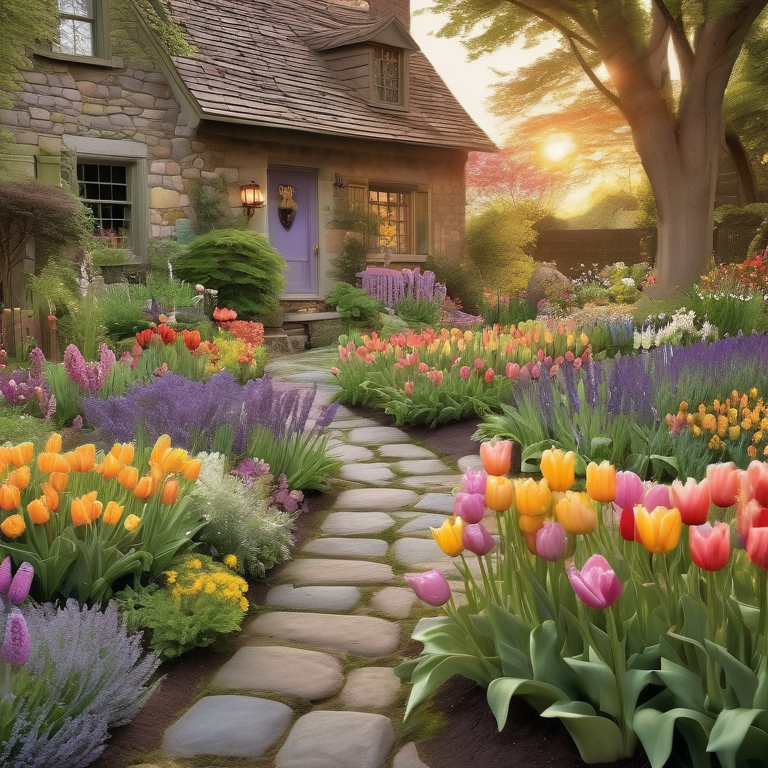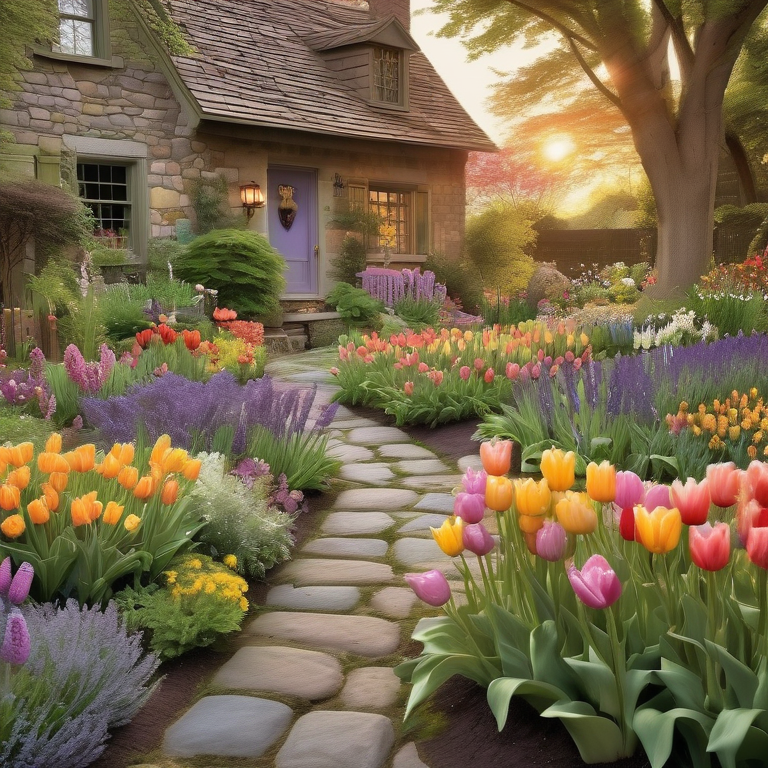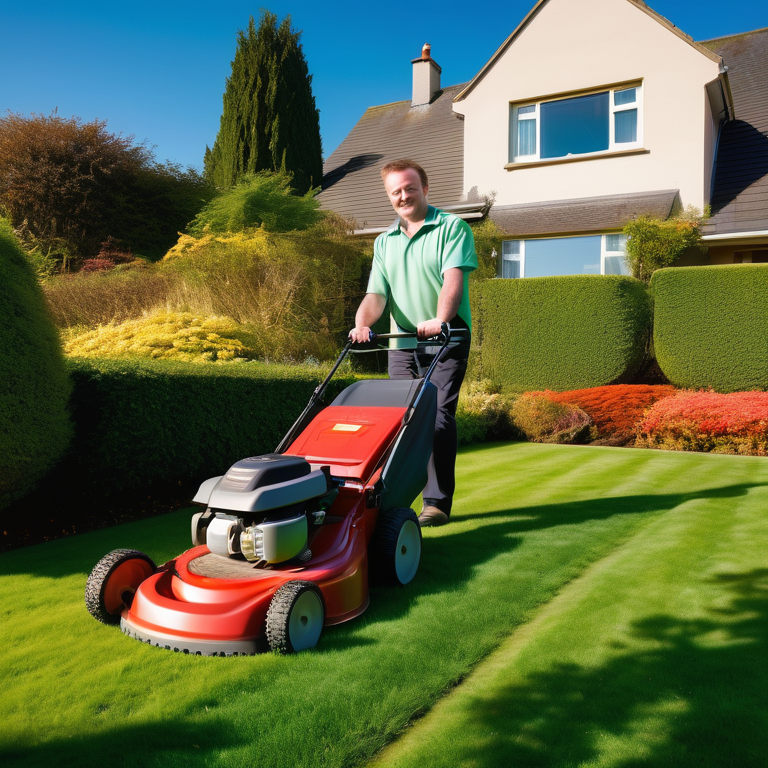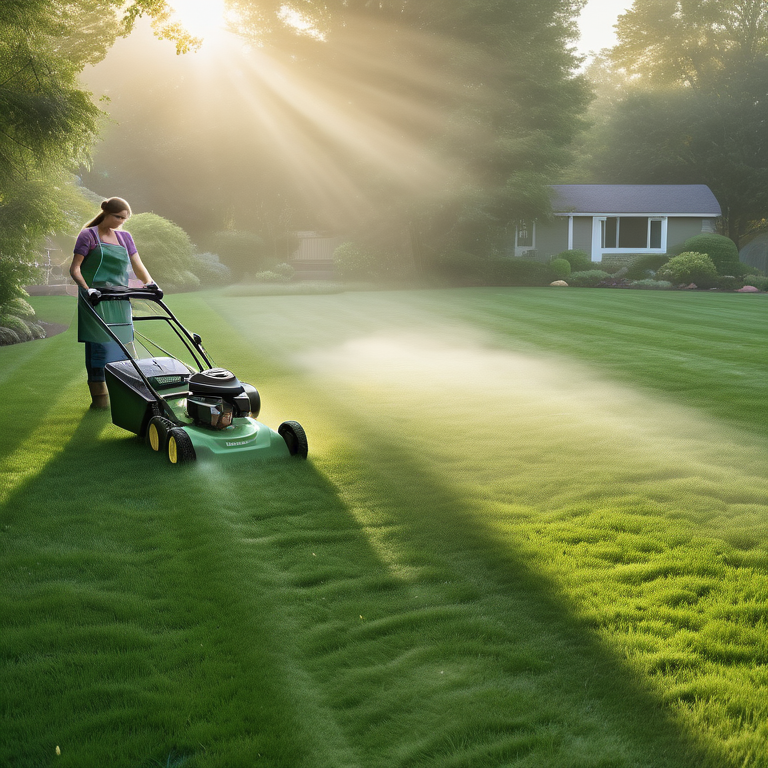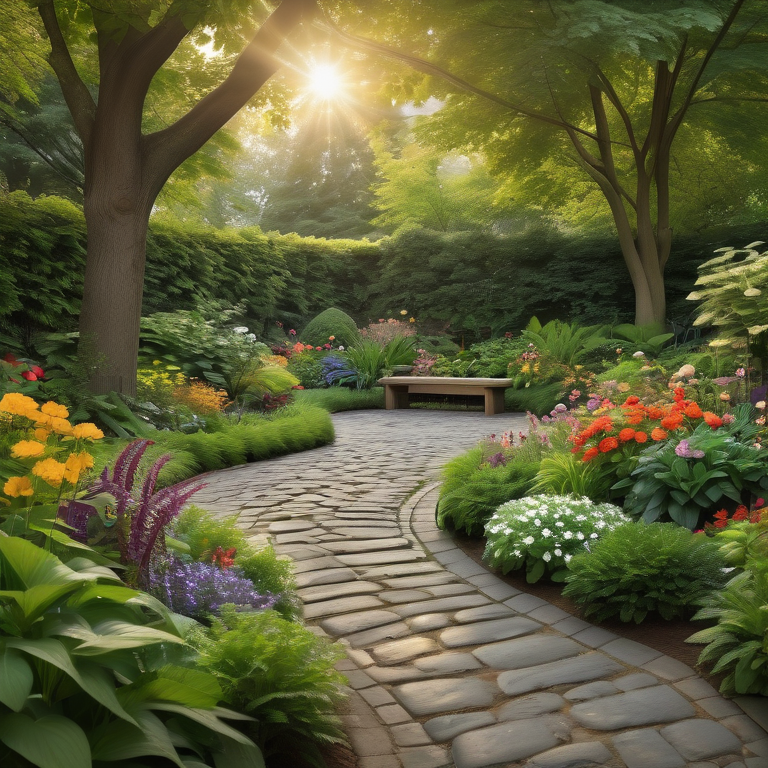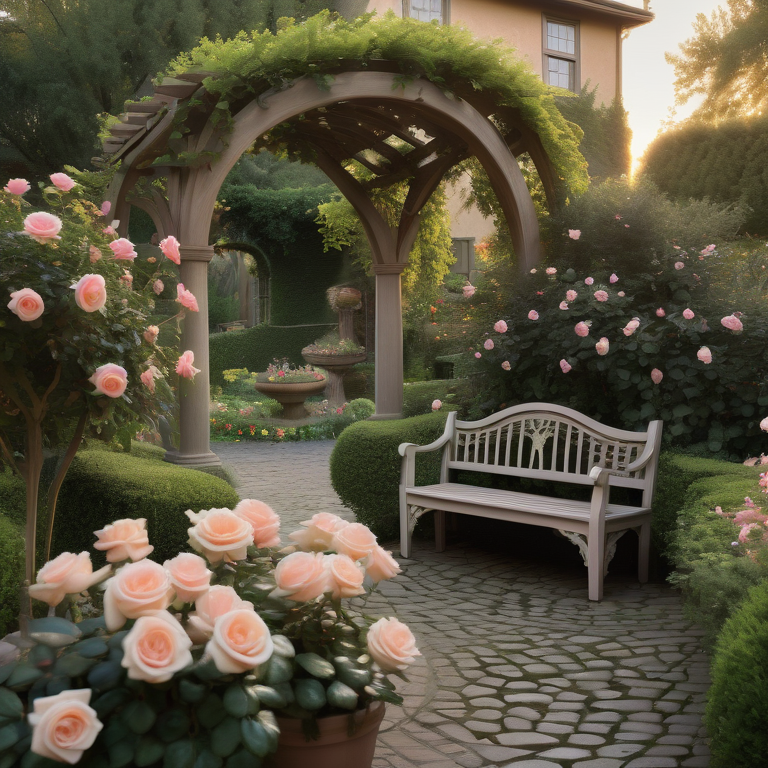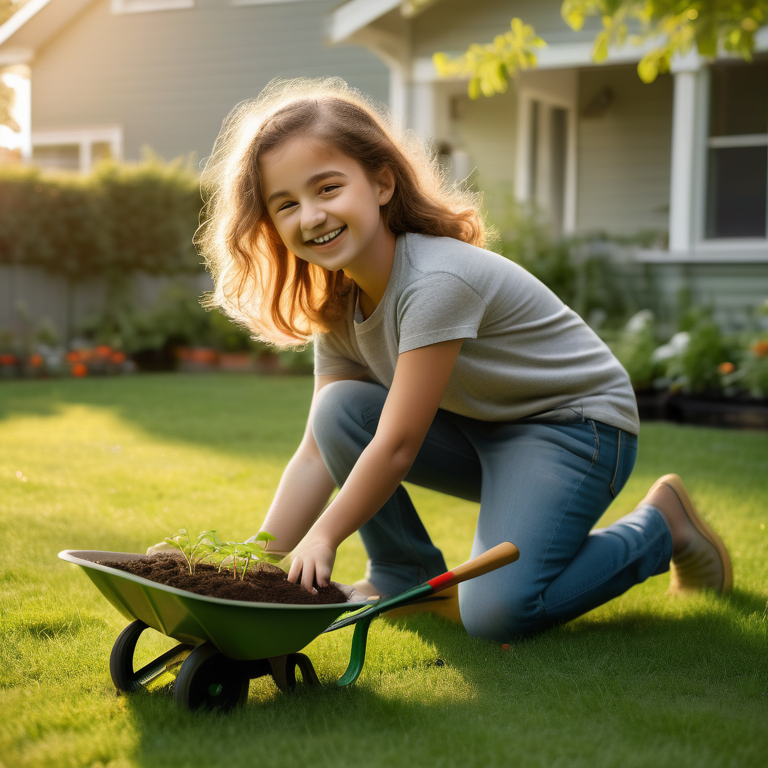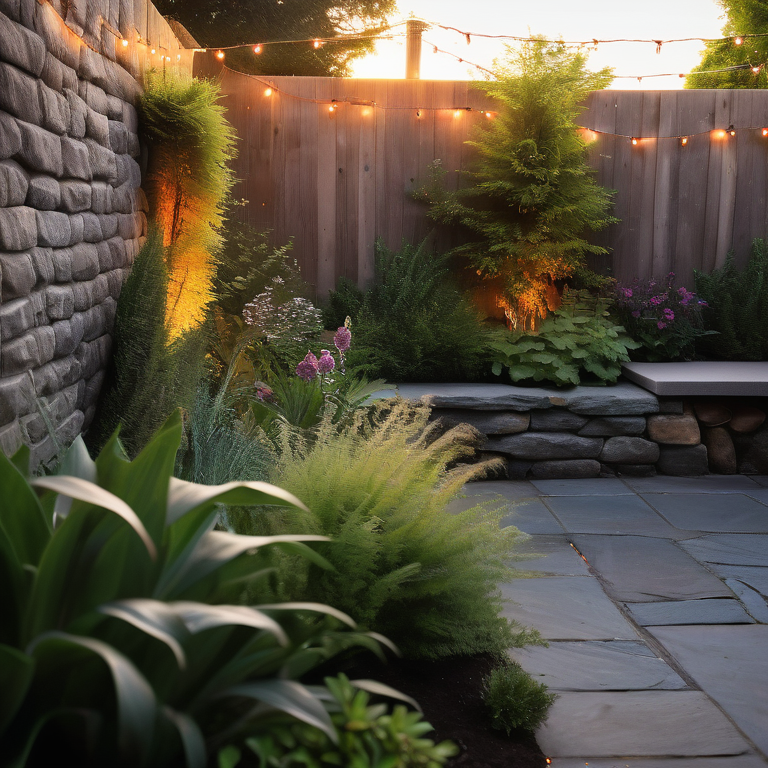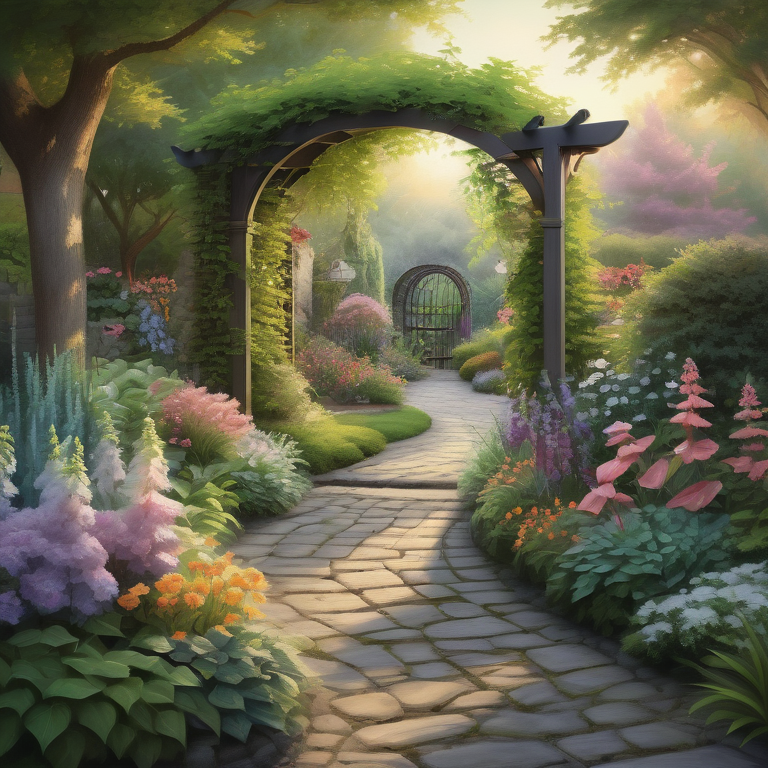Key Highlights
- Cottage gardens are a charming and practical option for small gardens, offering a mix of beauty and functionality.
- Key components of a cottage garden include hard landscaping, perennials, and thoughtful planting.
- Maximizing space in a small cottage garden can be achieved through creative layouts and vertical gardening techniques.
- Selecting the right plants is crucial for the year-round beauty of a small cottage garden.
- Incorporating features such as focal, architectural elements, seating areas, and pathways adds character and functionality to a small cottage garden.
Introduction
Small gardens have their own unique charm and can be transformed into beautiful outdoor spaces with the right design and planning. Cottage gardens, with their romantic and whimsical appeal, are a popular choice for small garden designs. They offer a mix of beauty, functionality, and practicality, making them ideal for those with limited garden space.
In this blog, we will explore expert tips and advice on designing a cottage garden for small gardens. We will delve into the essence of cottage gardening, the key components of a cottage garden, and how to plan and implement the design in a small space. With creative layouts, vertical gardening techniques, and strategic plant selection, you can create a stunning cottage garden that maximizes the available space and adds charm and character to your outdoor area.
Whether you have a small backyard, a compact patio, or a tiny balcony, these tips and ideas will help you create a beautiful and functional cottage garden that brings joy and tranquility to your outdoor space. Let’s dive in and discover how to design your own small cottage garden paradise.
Understanding Cottage Garden Design
To understand cottage garden design, it is helpful to explore the origins of these gardens. Cottage gardens have their roots in the traditional English garden style, characterized by a romantic and informal atmosphere. The key principle of cottage garden design is to create a space that looks natural and effortless, while still being carefully planned and maintained.
In a cottage garden, the emphasis is on using the right plant in the right place, with a mix of perennials, annuals, and flowering shrubs. The goal is to create a harmonious and balanced planting scheme that attracts pollinators and provides year-round interest. The use of natural materials, such as wood and stone, also adds to the rustic and timeless charm of a cottage garden. www.wicklowlandscaping.ie
The Essence of Cottage Gardening
The essence of cottage gardening lies in creating a beautiful and inviting outdoor space that feels connected to nature. Cottage gardens are characterized by their informal and naturalistic style, with an emphasis on using a wide variety of plants and incorporating natural materials.
One of the key aspects of a cottage garden is the use of natural materials, such as wood and stone, for pathways, seating areas, and other hardscaping elements. These materials add a rustic and timeless charm to the garden and create a sense of harmony with the surrounding environment.
Cottage gardens also prioritize the use of organic gardening practices, such as composting and companion planting, to create a healthy and sustainable ecosystem. By attracting pollinators and beneficial insects, cottage gardens support biodiversity and contribute to a thriving ecosystem.
Overall, the essence of cottage gardening is to create a space that feels intimate, welcoming, and in harmony with nature. It is a style of gardening that celebrates the beauty of imperfection and embraces the wild and whimsical aspects of the natural world.
Key Components of a Cottage Garden
The key components of a cottage garden include hard landscaping, perennials, and thoughtful planting. Hard landscaping refers to the non-living elements of the garden, such as paths, walls, and seating. In a cottage garden, these elements are typically made from natural materials like stone, brick, or wood, to enhance the rustic and timeless feel of the space.
Perennials are an essential part of a cottage garden, as they provide year-round beauty and require less maintenance than annuals. Common perennials found in cottage gardens include roses, lavender, delphiniums, and peonies. These plants add color, texture, and fragrance to the garden and attract pollinators.
Thoughtful planting is another key component of a cottage garden, as it involves choosing the right plants for the right place. Consider the sunlight, soil type, and moisture levels in your garden when selecting plants. Group plants with similar growing conditions together to create visually appealing and cohesive planting beds.
By incorporating these key components into your cottage garden design, you can create a charming and inviting outdoor space that celebrates the beauty of nature. www.wicklowlandscaping.ie
Planning Your Small Cottage Garden
When planning a small cottage garden, it’s important to make the most of the available space. Consider the following tips to help you create a well-designed and functional garden:
- Assess the size and shape of your garden to determine how to optimize the space. Consider the type of soil you have and whether any amendments are needed.
- Create a garden plan that includes flower beds, pathways, and focal points. Use the principles of balance and proportion to create a visually appealing layout.
- Choose plants that are suitable for small gardens, considering their mature size and growth habits. Opt for compact varieties and those that thrive in your specific growing conditions.
- Utilize vertical space by incorporating trellises, arbors, or hanging baskets. This will help maximize growing area while adding visual interest.
- Consider the overall theme or style you want to achieve in your cottage garden. Whether it’s a colorful and whimsical space or a more formal English garden, let your personal preferences guide your design choices.
By carefully planning your small cottage garden, you can create a beautiful and functional outdoor space that brings joy and relaxation.
Maximizing Space with Creative Layouts
In small gardens, it’s important to think creatively to maximize the available space. Here are some ideas to help you make the most of your small cottage garden:
- Create Different Levels: Incorporate different levels in your garden by using raised beds, terraces, or steps. This adds visual interest and makes the space feel larger by breaking up the landscape.
- Utilize Raised Beds: Raised beds are a great solution for small gardens as they provide additional planting space and help define different areas. They also make it easier to control soil quality and drainage.
- Explore Vertical Gardening: Use trees, arches, or walls to grow climbing plants and add vertical interest to your garden. This not only maximizes space but also creates a beautiful backdrop for your plants.
- Get Creative with Containers: Use containers of various sizes and shapes to grow plants. This allows you to move them around to create different arrangements and adapt to changing seasons or plant preferences.
- Incorporate Garden Ideas: Consider unique garden ideas such as vertical herb gardens, hanging baskets, or even a small greenhouse. These features add functionality and visual appeal to your small cottage garden.
By incorporating these creative layout ideas into your small garden design, you can make the most of the available space and create a beautiful and functional outdoor oasis. www.wicklowlandscaping.ie
Selecting Plants for Year-Round Beauty
When selecting plants for your small cottage garden, it’s important to choose varieties that will provide year-round beauty. Here are some plant suggestions to consider:
- Sweet peas: These fragrant climbers are a classic choice for cottage gardens. They come in a variety of colors and can be trained to grow up trellises or other vertical supports.
- Runner beans: Not only do runner beans produce tasty edible pods, but they also have attractive flowers that add color and interest to the garden. They prefer full sun and can be trained to grow on trellises or poles.
- Perennials: Choose a mix of flowering perennials that will provide color throughout the seasons. Consider plants like lavender, salvia, and hardy geraniums for their long-lasting blooms and low maintenance requirements.
- Foliage Plants: Don’t forget about the importance of foliage in a cottage garden. Plants like ferns, hostas, and heucheras can provide texture and interest even when they are not in bloom.
By selecting a mix of plants that provide year-round beauty, including flowers, foliage, and climbers, you can create a vibrant and visually appealing small cottage garden. www.wicklowlandscaping.ie
Implementing Key Features in Your Garden
To create a charming and functional small cottage garden, it’s important to implement key features that add interest and structure to the space. Consider the following elements:
- Focal Point: Create a focal point in your garden, such as a decorative statue, a water feature, or a beautiful flowering tree. This will draw the eye and create a sense of depth in the garden.
- Architectural Elements: Incorporate architectural elements like trellises, archways, or pergolas to add height and visual interest. These structures can also provide support for climbers and create shaded seating areas.
- Seating Area: Include a seating area where you can relax and enjoy your garden. This can be as simple as a bench or a more elaborate seating arrangement depending on the size of your garden.
- Pathways: Create pathways that lead through your garden, connecting different areas and guiding the flow of traffic. Use materials that complement the style of your garden, such as gravel or natural stone.
By implementing these key features in your small cottage garden, you can create a visually appealing and functional outdoor space that reflects your personal style. www.wicklowlandscaping.ie
Incorporating Pathways and Edging
Pathways and edging play an important role in the overall design and functionality of a small cottage garden. Here are some tips for incorporating pathways and edging in your garden:
- Gravel Pathways: Gravel is a popular choice for pathways in cottage gardens as it provides a rustic and natural look. It’s also relatively easy to install and maintain. Consider using different sizes and colors of gravel to create visual interest.
- Walkway Materials: If gravel isn’t your preference, there are many other materials to choose from for walkways, such as natural stone, brick, or concrete pavers. Select a material that complements the style of your garden and provides a solid surface to walk on.
- Edging: Use edging materials, such as stone or metal, to define the borders of your pathways and flower beds. This helps to keep the garden organized and prevents plants from encroaching on the pathways.
- Curved Pathways: Consider incorporating curved pathways in your garden to add visual interest and create a more natural and inviting flow. Curved pathways also help to soften the overall look of the garden.
By incorporating well-designed pathways and edging in your small cottage garden, you can create a cohesive and visually appealing outdoor space. www.wicklowlandscaping.ie
Utilizing Vertical Spaces for Growth
In a small cottage garden, utilizing vertical spaces for growth is essential to maximize the available space. Here are some ideas for utilizing vertical spaces:
- Green Walls: Create a green wall by installing vertical planters or hanging baskets on a fence or exterior wall. This not only adds greenery but also acts as a focal point and adds visual interest.
- Trellises and Arbors: Install trellises or arbors in your garden to support climbing plants. This allows plants to grow vertically, saving space and creating a lush and beautiful backdrop for your garden.
- Climbing Plants: Choose climbers such as clematis, honeysuckle, or jasmine to grow on trellises or walls. These plants not only add beauty and fragrance but also create privacy and shade in a small garden.
- Hanging Baskets: Hang baskets filled with trailing plants or flowers from walls, fences, or pergolas. This adds color and visual interest at eye level and frees up ground space for other plantings.
By utilizing vertical spaces for growth, you can create a lush and beautiful small cottage garden that maximizes space and adds visual appeal.
Essential Plants for a Cottage Garden
Essential plants are the backbone of a cottage garden, providing beauty, fragrance, and interest throughout the seasons. Here are some essential plants to consider for your small cottage garden:
- Lavender: Known for its beautiful purple flowers and delightful fragrance, lavender is a must-have in any cottage garden. It thrives in full sun and well-drained soil.
- Fragrant Herbs: Include fragrant herbs like rosemary, thyme, and mint in your cottage garden. Not only do they add scent and flavor to your cooking, but they also attract pollinators.
- Foliage Plants: Ferns and other foliage plants add texture and interest to a cottage garden. Their lush green leaves provide a beautiful backdrop for flowering plants.
- Shade-Loving Plants: If your garden has shady areas, consider incorporating shade-loving plants like hostas, heucheras, and ferns. These plants thrive in low-light conditions and add depth to your garden.
By including these essential plants in your small cottage garden, you can create a beautiful and fragrant outdoor space that evokes the charm of a traditional cottage garden.
Fragrant Herbs and Flowering Perennials
Fragrant herbs and flowering perennials are essential elements of a cottage garden, providing both beauty and fragrance throughout the seasons. Here are some suggestions for fragrant herbs and flowering perennials to include in your small cottage garden:
- Herbs: Rosemary, lavender, thyme, and mint are all fragrant herbs that can add a delightful aroma to your garden. These herbs are also versatile in the kitchen and attract beneficial pollinators.
- Flowering Perennials: Peonies, irises, dianthus, and daylilies are just a few examples of flowering perennials that can add color and fragrance to your cottage garden. Choose a mix of plants that bloom at different times to ensure a continuous display of flowers.
- Pollinator-Friendly Plants: Incorporate plants that attract pollinators such as bees and butterflies, including butterfly bush, echinacea, salvia, and verbena. These plants not only add beauty to your garden but also support important pollinators.
By including fragrant herbs and flowering perennials in your small cottage garden, you can create a delightful sensory experience and attract beneficial pollinators to your outdoor space. www.wicklowlandscaping.ie
Climbers and Creepers for Fences and Walls
Climbing plants and creepers are excellent choices for adding vertical interest and beauty to fences and walls in a small cottage garden. Here are some options to consider:
- Climbers: Clematis, honeysuckle, and jasmine are popular choices for climbing plants that add fragrance and color to your garden. Train them to grow on trellises or up walls for a stunning effect.
- Creepers: Creeping plants, such as ivy or creeping thyme, can be planted at the base of fences or walls to provide ground cover and soften the hard edges. They can also help to create a more natural and organic look.
- Wisteria: Wisteria is a classic choice for covering walls or pergolas in a cottage garden. Its beautiful cascading blooms and delicate fragrance are a sight to behold.
By incorporating climbers and creepers into your small cottage garden, you can enhance the vertical spaces in your garden and create a stunning and inviting outdoor space. www.wicklowlandscaping.ie
Design Tips for a Small Cottage Garden
Designing a small cottage garden requires careful thought and consideration to make the most of the available space. Here are some design tips to help you create a beautiful and functional outdoor space:
- Color Schemes: Choose a color scheme that complements the style of your cottage garden, such as pastels for a soft and romantic look or bold and vibrant colors for a more lively and energetic feel.
- Plant Textures: Incorporate a mix of plant textures, such as feathery ferns, spiky grasses, and delicate flowers, to add visual interest and variety to your garden.
- Visual Relief: Create visual relief in your garden by incorporating different heights and levels. This can be achieved through the use of raised beds, trellises, or stepping stones.
- Contrast and Balance: Strive for balance and contrast in your cottage garden design by combining plants with different shapes, sizes, and colors. This will create a visually appealing and harmonious space.
By following these design tips, you can create a small cottage garden that is both aesthetically pleasing and functional, providing a beautiful outdoor retreat.
Color Schemes and Plant Textures
Color schemes and plant textures play a vital role in creating a visually appealing small cottage garden. Here are some tips to consider when selecting colors and textures for your garden:
- Color Schemes: Choose a color scheme that complements the style of your cottage garden. Consider using a mix of pastel colors for a soft and romantic look or bold and vibrant colors for a more lively and energetic feel.
- Plant Textures: Incorporate a variety of plant textures to add visual interest and depth to your garden. Combine plants with different leaf shapes, sizes, and textures, such as feathery ferns, spiky grasses, and velvety flowers.
- Visual Relief: Create visual relief in your garden by using plants with different heights and levels. This can be achieved through the use of raised beds, and trellises, or by planting taller plants in the background and shorter plants in the foreground.
- Foliage: Don’t forget about the importance of foliage in a cottage garden. Choose plants with interesting foliage, such as variegated leaves or plants with colorful foliage, to add texture and visual interest even when they are not in bloom.
By carefully selecting color schemes and plant textures, you can create a visually appealing small cottage garden that is both beautiful and inviting.
Balancing Aesthetics and Functionality
Balancing aesthetics and functionality is crucial when designing a small cottage garden. Here are some tips to help you achieve this balance:
- Consider your own garden needs and preferences. Think about how you want to use your outdoor space and what elements are most important to you, whether it’s a seating area for entertaining or a space for growing your own vegetables.
- Prioritize functionality without sacrificing aesthetics. Choose plants and features that not only look beautiful but also serve a purpose, such as providing shade or attracting pollinators.
- Make the most of the available space. Utilize vertical gardening strategies, such as trellises or hanging baskets, to maximize growing area. Create distinct zones within your garden for different activities or plant groupings.
- Avoid overcrowding. While it’s important to maximize space, it’s equally important to avoid overcrowding. Leave enough room for plants to grow and for you to move around comfortably.
By finding the right balance between aesthetics and functionality, you can create a small cottage garden that is both beautiful and practical, providing a space that you can truly enjoy. www.wicklowlandscaping.ie
DIY Projects for Garden Personalization
Adding a personal touch to your small cottage garden can be achieved through various DIY projects. Here are some ideas to personalize your garden:
- Creating a Rustic Trellis: Build a rustic trellis using natural materials like sticks or branches. This adds a unique and organic element to your garden and provides support for climbing plants.
- Building Raised Beds: Construct raised beds using wood or stone to create defined growing areas. This not only adds visual interest but also allows for better soil management and drainage.
- Using Natural Materials: Incorporate natural materials like wood chips, pebbles, or decorative stones for pathways or mulch. These materials add texture and a rustic feel to the garden.
By undertaking these DIY projects, you can personalize your small cottage garden and create a space that reflects your own style and creativity. www.wicklowlandscaping.ie
Creating a Rustic Trellis
Creating a rustic trellis is a great DIY project that adds a charming and natural touch to your small cottage garden. Here’s how to create a rustic trellis:
- Gather Materials: Collect sticks or branches of similar lengths and thicknesses. Choose materials that are sturdy and can withstand the weight of climbing plants.
- Measure and Cut: Determine the desired height and width of your trellis. Cut the branches to the appropriate lengths using a saw or pruning shears.
- Assemble the Trellis: Lay out the branches horizontally, slightly overlapping them to create a grid-like pattern. Use twine or wire to secure the branches at each intersection. Alternatively, weave the branches together for a more rustic look.
- Install and Support: Dig holes in the ground where you want to install the trellis. Insert the bottom ends of the branches into the holes and fill them with soil to provide stability. Secure the trellis to a wall or fence if necessary.
- Train Climbing Plants: Once the trellis is installed, train climbing plants to grow up and around the branches. This will create a beautiful and natural display of foliage and flowers.
By creating a rustic trellis, you can add a unique and personal touch to your small cottage garden while providing support for climbing plants.
Building Raised Beds for Efficient Gardening
Building raised beds in your small cottage garden is a practical and efficient gardening solution. Here’s how to build raised beds:
- Determine Size and Location: Decide the size and location of your raised beds based on the available space and sunlight requirements of the plants you want to grow. Raised beds should be narrow enough to reach comfortably from each side.
- Select Materials: Choose materials that are rot-resistant, such as cedar or pressure-treated lumber. Avoid using treated wood if you plan to grow edible plants. Alternatively, use bricks or stones to build the raised beds.
- Build the Beds: Assemble the raised beds by connecting the sides with screws or nails. Make sure the corners are square and the bed is level.
- Fill with Soil: Fill the raised beds with a mixture of topsoil, compost, and organic matter. This will provide a nutrient-rich growing medium for your plants.
- Plant and Maintain: Plant your desired crops in the raised beds, such as salad leaves or cherry tomatoes. Regularly water and maintain the beds to ensure healthy plant growth.
By building raised beds, you can optimize space, improve soil quality, and create a more efficient and productive small cottage garden. www.wicklowlandscaping.ie
Attracting Wildlife to Your Garden
Creating a small cottage garden that attracts wildlife is not only beneficial for the environment but also adds interest and enjoyment to your outdoor space. Here are some tips for attracting wildlife to your garden:
- Provide Food Sources: Plant flowers that attract pollinators, such as bees and butterflies. Install bird feeders and provide water sources, such as birdbaths or small ponds, for birds and other wildlife.
- Create Habitat: Incorporate native plants and shrubs to create a diverse and natural habitat for wildlife. Include nesting boxes, log piles, or rock piles to provide shelter and nesting opportunities.
- Avoid Chemicals: Minimize the use of pesticides and herbicides in your garden to protect wildlife and promote a healthy ecosystem.
By creating a wildlife-friendly garden, you can enjoy the beauty of nature up close and contribute to the conservation of local wildlife populations. www.wicklowlandscaping.ie
Plant Choices That Invite Pollinators
Choosing the right plants can help attract pollinators to your small cottage garden. Here are some plant choices that invite pollinators:
- Bee-Friendly Plants: Include flowers like lavender, sunflowers, borage, and bee balm to attract bees. These plants provide nectar and pollen for bees to feed on.
- Butterfly-Friendly Plants: Plant flowers like butterfly bush, milkweed, coneflower, and lantana to attract butterflies. These plants provide nectar and caterpillar food sources.
- Nectar-Rich Flowers: Choose flowers with nectar-rich blooms, such as zinnias, cosmos, salvia, and verbena. These flowers are attractive to both bees and butterflies and provide a valuable food source.
- Native Wildflowers: Incorporate native wildflowers into your garden as they are well-adapted to the local ecosystem and provide important food sources for pollinators.
By including these plant choices in your small cottage garden, you can create a haven for pollinators and contribute to their conservation. www.wicklowlandscaping.ie
Water Features and Bird Feeders
Water features and bird feeders not only attract wildlife but also add a sense of tranquility and relaxation to your small cottage garden. Here are some ideas to consider:
- Water Features: Install a small pond, birdbath, or fountain in your garden to provide a water source for birds and other wildlife. This will also create a soothing and calming atmosphere.
- Bird Feeders: Hang bird feeders filled with seeds, nuts, or suet to attract a variety of bird species. Place the feeders in a location where they can be easily seen from your seating area for maximum enjoyment.
- Providing Shelter: Incorporate birdhouses or nesting boxes in your garden to provide shelter and nesting opportunities for birds.
- Garden Wildlife: Create a diverse and wildlife-friendly garden by incorporating native plants, shrubs, and trees that provide food and shelter for a variety of species.
By adding water features and bird feeders to your small cottage garden, you can create a peaceful and inviting space that attracts a variety of garden wildlife. www.wicklowlandscaping.ie
Seasonal Care and Maintenance
Proper care and maintenance are essential for keeping your small cottage garden looking its best throughout the seasons. Here are some tips for seasonal care:
- Autumn: Remove spent annuals and cut back perennials. Mulch around plants to protect them during the winter. Plant spring-flowering bulbs for a burst of color in the following season.
- Winter: Protect tender plants from frost and cold temperatures by covering them or moving them indoors. Prune trees and shrubs as needed.
- Spring: Remove winter mulch and clean up any debris. Start preparing the soil for planting and plant spring-blooming bulbs and early-season annuals.
- Summer: Water and fertilize plants regularly, especially during hot and dry periods. Deadhead spent flowers to encourage continuous blooming. Monitor for pests and diseases and take appropriate action if necessary.
By following these seasonal care and maintenance tips, you can ensure that your small cottage garden looks its best year-round and continues to thrive.
Preparing for Spring Blooms
Preparing your small cottage garden for spring blooms is an exciting time for gardeners. Here are some tips to help you get your garden ready for the upcoming season:
- Clean Up: Remove any dead leaves, debris, or spent plants from the previous season. This will help prevent pests and diseases from overwintering in your garden.
- Prune: Prune any shrubs or trees that may need shaping or rejuvenation. Remove dead or damaged branches to promote new growth.
- Soil Preparation: Amend your soil with compost or organic matter to improve its fertility and drainage. This will provide a nutrient-rich environment for your plants to thrive.
- Plant Spring-Blooming Bulbs: Plant bulbs like daffodils, tulips, and crocuses in the fall for a burst of color in the spring. Follow the planting instructions for each bulb variety.
- Sow Annuals and Perennials: Start sowing seeds of annuals and perennials indoors or directly in the garden, depending on the plant’s requirements. Consider planting colorful flowers like poppies, pansies, or primroses for early spring blooms.
By preparing your small cottage garden for spring blooms, you can ensure a vibrant and colorful display of flowers that will bring joy and beauty to your outdoor space. www.wicklowlandscaping.ie
Managing the Cottage Garden in Winter
Winter care is crucial to protect your small cottage garden and ensure its health and vitality. Here are some tips for managing your garden in winter:
- Frost Protection: Cover tender plants with frost blankets or horticultural fleece to protect them from freezing temperatures. Move potted plants indoors or to a sheltered location.
- Mulch: Apply a layer of mulch around the base of plants to insulate the soil and protect the root system. This will help prevent frost damage and provide moisture retention.
- Prune: Prune any dead or damaged branches from trees and shrubs to prevent them from breaking under the weight of snow or ice.
- Bark: Protect the base of trees and shrubs from frost damage by adding a layer of bark or straw around the base. This will insulate the roots and provide additional protection.
By taking these winter care measures, you can ensure the health and longevity of your small cottage garden throughout the colder months.
Solutions for Common Cottage Garden Challenges
Dealing with limited space in a small garden can be challenging, but by utilizing vertical spaces for growth and incorporating different levels, you can maximize your garden space efficiently. Controlling invasive species is crucial; consider planting the right plants in the right place to prevent them from taking over. Implement natural materials like wood chips or bark for a traditional cottage garden feel while providing visual relief.
Dealing with Limited Space
Creating a lush cottage garden in a small space requires strategic planning. Opt for vertical gardening with climbers like sweet peas and runner beans to maximize garden space. Utilize containers for growing cherry tomatoes and salad leaves. Incorporate raised beds for different levels of planting. Implement trellises and arbour structures to add visual interest without taking up much floor area. Choose plants that thrive in limited spaces like lavender or ferns. By thinking creatively and utilizing every inch efficiently, you can transform even the smallest area into a charming cottage garden.
Controlling Invasive Species
In managing your small cottage garden, controlling invasive species is crucial to maintaining a harmonious ecosystem. Identify and remove any aggressive plants that can overrun your garden and outcompete native species. Regularly inspect your garden for invasive plants like Japanese knotweed or Himalayan balsam, and promptly eliminate them to prevent their spread. Consider using natural methods or environmentally friendly herbicides to tackle invasive species while preserving the health of your garden. Stay vigilant to protect the diversity and balance of your precious garden space. www.wicklowlandscaping.ie
Conclusion
In conclusion, designing a cottage garden for small spaces is about maximizing every inch with creativity and selecting the right plants for year-round beauty. By incorporating key features like pathways, edging, and vertical growth spaces, you can create a harmonious and functional outdoor sanctuary. Remember to balance aesthetics with functionality, use color schemes wisely, and attract wildlife for a vibrant ecosystem. Embrace DIY projects for personalizing your garden and stay on top of seasonal care and maintenance for a flourishing cottage garden year after year. Start your journey towards a picturesque and inviting cottage garden today! www.wicklowlandscaping.ie
Frequently Asked Questions
How to Start a Cottage Garden in a Small Space?
Begin your small cottage garden by selecting a variety of compact plants for year-round beauty. Maximize space with creative layouts and utilize vertical spaces for growth. Incorporate pathways, edging, and essential plants like fragrant herbs and climbers.
What Are the Best Plants for a Cottage Garden?
For a flourishing cottage garden, consider planting fragrant herbs like lavender and rosemary, along with vibrant perennials such as peonies and daisies. Climbers like clematis and roses add vertical interest, while foxgloves and delphiniums bring color. Enhance with sweet peas for a charming touch.
Tips for Maintaining a Cottage Garden with Minimal Effort
Discover low-maintenance strategies for sustaining your cottage garden effortlessly. Embrace drought-resistant plants, mulching for weed control, and strategic plant placement for optimal growth. Simplify your gardening routine with these expert tips.
